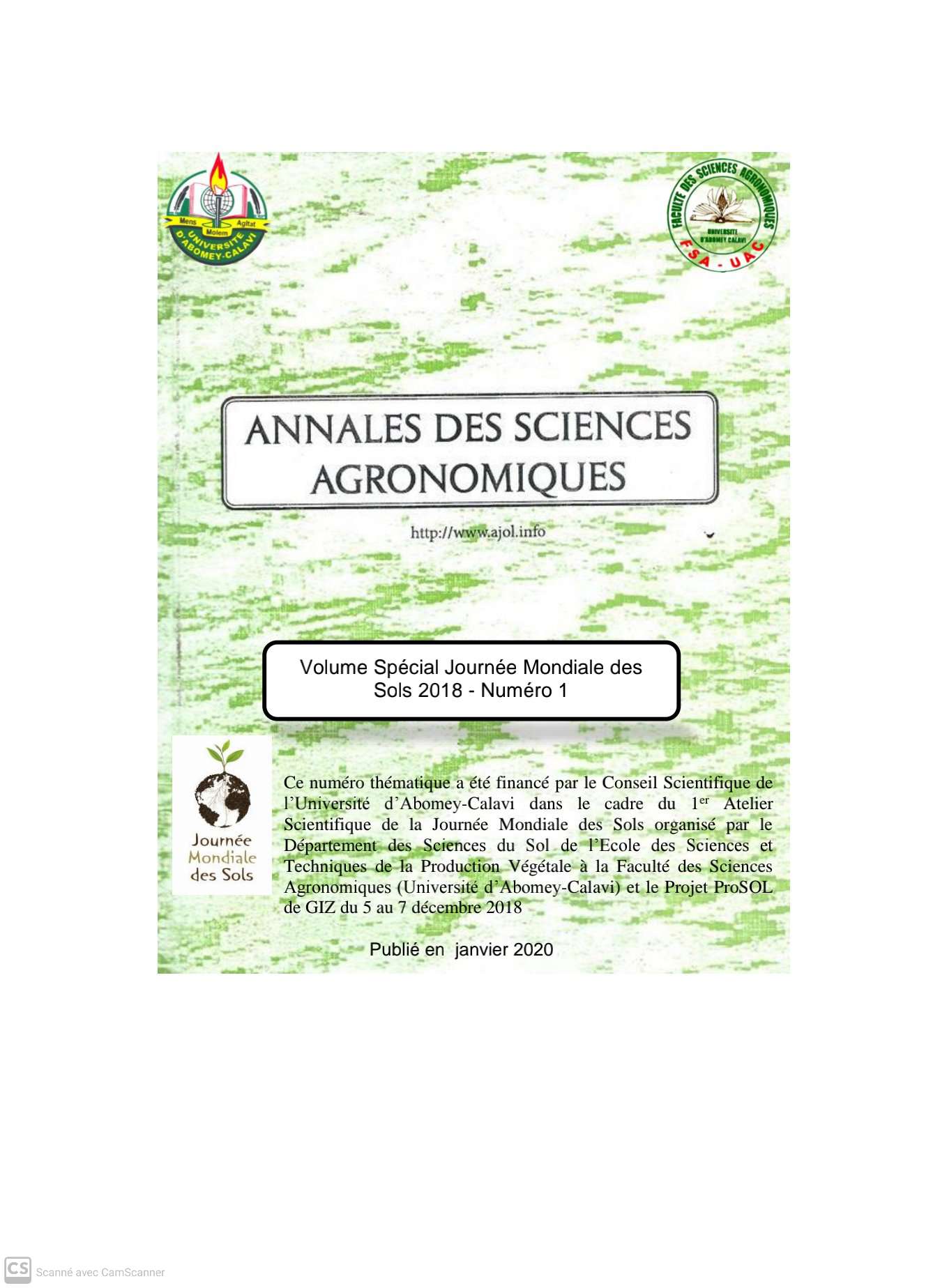FORÊT COMME TECHNOLOGIE NATURELLE DE CONSERVATION DURABLE DES TERRES AU BÉNIN
M. R. OGOUNCHI*, H. DEDEHOUANOU* & F. HOUNNOU*
DOI:
https://doi.org/10.2023/gxneg397Keywords:
Deforestation, land use; planning, optimal stock of forestAbstract
Most developing countries rely on their natural resources that they harness and export. Over time, pressure
on those natural resources escalates and social and economic welfare of people deteriorate. In Benin,
agriculture is among the major sources of income. Several governments have put emphasis, through policies
and regulations, on the promotion of agricultural sector. However, agricultural development impedes on
forest preservation and soil conservation. Our study aims at analyzing the role of forest and proposing a
planning model of land use in order to restore and conserve forests and agricultural soils in Benin. For this
purpose, a linear optimization model was used and relevant variables such as forest areas, reforested areas
and agricultural areas were identified and collected over 25 years (1990-2015). The results of the study
showed that real forest stock was under the optimal level since 1984, this is to imply that soils and forests
have not been used efficiently in the past. To that effect, a spatial model where the forest cover increases
from 38% to 69% was proposed as well as some pathways for a sustainable use of forest resources in line
with soil conservation.
References
BURNEY J. A., DAVIS S. J. & LOBELL D. B., 2010.Greenhouse gas mitigation by Agricultural
intensification. Proceedings of The National Academy of Sciences USA 107 (26), 12052–12057.
COULIBALY N., 2016. Optimal Forest Stock Determination in Côte d’Ivoire, in a Sustainable Development
Perspective.
American Journal of Environmental Protection. Vol. 5, No. 6, 2016, pp. 157-167. doi:
11648/j.ajep.20160506.13
DEFRIES R. & ROSENZWEIG C., 2010. "Toward a whole-landscape approach for sustainable land use in
the tropics" NASA Publications. 43.
DGFRN, 2011. Rapport annuel d’activité 2010. 63p
EVELYN O. B., 2009. Utilizing geographic information system (GIS) to determine optimum forest cover for
minimizing runoff in a degraded watershed in Jamaica.
International Forestry Review Vol. 11(3),
Forestry Department, 173 Constant Spring Road, Kingston 8, Jamaica
EWERS M. R., KAPOS V., COOMES D. A., LAFORTEZZA R. & DIDHAM R. K., 2009. Mapping community
change in modified landscapes. Biological Conservation 142 (2009) 2872–2880
FAO, 2010: Global Forest Resources Assessment 2010: Final Report. FAO Forestry paper 163 p., FAO, Rome
INNES J. L., 2007. Forests in environmental protection. Forests and forest plants – Vol. I - Forests in
Environmental Protection Faculty of Forestry, University of British Columbia, Canada. 7p
KAPOS V., KURZ W. A., GARDER T., FERREIRA J., GUARIGUATA M., 2012. Impacts of forest and land
management on biodiversity and carbon. In : Parrotta J. A., Wildburger C. and Mansourian S,
(Eds), Understand relationships between biodiversity, carbon, forests and people: The key to
achieving REDD+ objectives. Vienna, Austria: International Union of Forest Research
Organizations.
MAEP & INRAB, 2016. Catalogue Béninois des Espèces et Variétés végétales ((CaBEV)).
.
INRAB/DPVPPAAO/ProCAD/MAEP & CORAF/WAAPP. 339 p. Dépôt légal N° 8982 du 21 octobre
, Bibliothèque Nationale (BN) du Bénin, 4ème trimestre. ISBN : 978-99919-2-548-6.
NABUURS G. J., PUSSINEN A.,VAN BRUSSELEN J. & SCHELHAAS M. J., 2007. Future harvesting
pressure on European forests. Eur. J. For. Res., 126 (2007), pp. 391-400
POWPA (
Appui aux Actions Nationales dans le cadre du Programme de Travail de la CDB sur les Aires
Protégées), 2010
. Rapport définitif d’Elaboration de mécanisme et d’outils pour l’évaluation
économique des aires protégées dans le cadre de la mise en œuvre du POWPA, 100 p.
ROYAL SOCIETY OF LONDON, 2009. Reaping the benefits: science and the sustainable intensification of
global agriculture. ISBN : 978-0-85403-784-1. 86p
WILSON P. M., PETTICREW M., CALNAN M. W. & NAZARETH I., 2010. Does dissemination extend
beyond publication: a survey of a cross section of public funded research in the UK. Implement Sci.
: 61.
FAO, http://www.fao.org/faostat/fr/#data, page consultée en Novembre 2017.
Banque mondiale, https://donnees.banquemondiale.org/pays/benin?view=chart, page consultée en
Novembre 2017.


